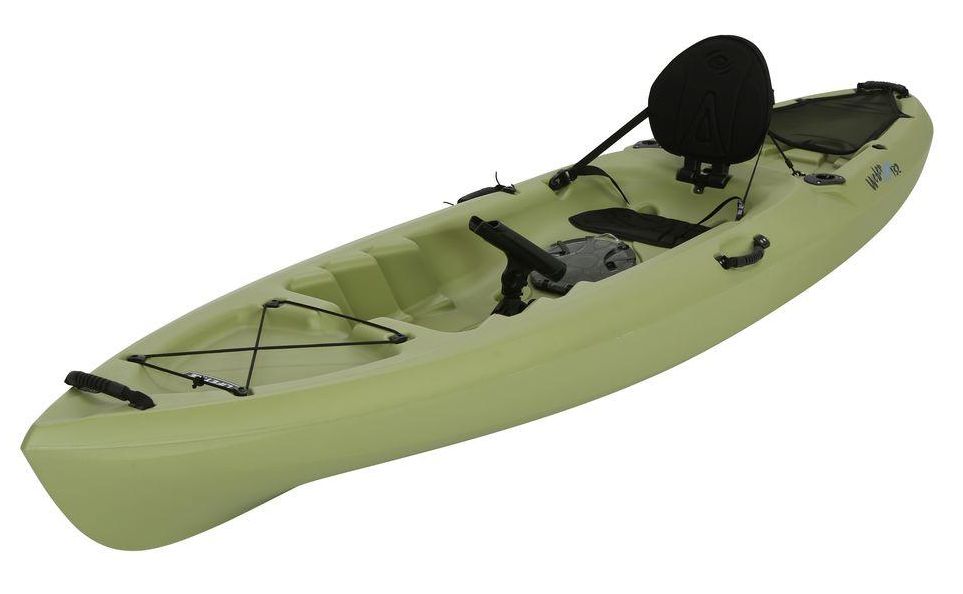Lifetime Weber Angler 110

Specs:
- Length: 11 feet overall
- Beam: 30"
- Height: 14" (hull only)
- Weight: 59.3 pounds
- Capacity: 300 pounds
- MSRP: $599, $540 street
Hits:
- best directional stability
- solid seat back
- roomy, even with dog on board
- easily accessible dry storage
- useful little wheel in the skeg
- 4 real handles
- central rod holder (removeable)
Misses:
- long and heavy
- slightly narrow cockpit
- somewhat cumbersome on the water ( compared to smaller boats )
- non-standard scupper hole spacing
- scupper holes under the seat get you wet
I stumbled into kayaking when I got this boat for free. I write product reviews for (the big orange store) and one day they offered a bunch of kayaks. Who even knew they sold kayaks? So I took the biggest one on offer, with all the fishing accessories, just in case I ever wanted to molest some fish. A few weeks later it was drop-shipped on my driveway in a big cardboard box. And I was a kayaker.
When I picked this boat, I knew nothing about kayaks, but I chose well. These Lifetime boats are a great compromise between price and capability, and they are built like tanks. Years of use have done no significant damage at all, just some scratches and a few small parts that needed to be replaced.
The folding seatback is excellent, but the seat cushion is a cruel joke, as with all these boats, it seems. Add some extra padding as I detailed elsewhere. The included paddle is decent, but a little short for me, so I got a better one.
For years I took the dog with me. Fishing with the dog in the boat didn't seem like a good idea, but after he passed on, I tried it, and this boat is an excellent platform. It has the tracking and stability you need to take your hands off the paddle and fiddle with other things.
The main hatch is terrific, see-through with easy latches. I tied a big Tupperware inside the hull for a glove compartment. Even if a little water gets in the hull ( actually, that has never happened ) the Tupperware will keep things dry. I also added a big hatch to the bow so I could store things there. The bow hatch is also useful if something gets loose inside the hull - you can stand the boat on its nose, give it a shake, and get your car keys back lickety-split. Try shaking something to the middle of the boat - good luck with that.
The scuppers are a bit of a design flaw. The spacing is much narrower than what seems to be standard, and I had to modify my scupper-cart to fit, not that big a deal really. Worse is that one set of scuppers is directly below the seat, and in choppy water it gets your butt wet. Standard scupper plugs won't fit, so I made a set from rubber stoppers. I drilled a hole down the center for a cord, which lets them drain slowly, but not splash up.
This boat is heavy and long, and it has only gotten heavier as I rigged it out. I can lug it short distances by myself, and the skeg wheel is very useful on smooth hard surfaces but jams up quickly on gravel or sand. While two people can easily carry it and could probably even get it up on the truck rack without too much difficulty, this boat gets the prime spot in the bed. To move it any more than a few yards by yourself, you're going to need a good kayak cart.
Some other long-term results:
- After several years, the netting on the stern rotted away from the sun. It also blew off once while I was driving, but I doubled-back and found it and tied it down better. I don't plan to replace it.
- The plastic buckles on the seat straps have a tendency to break if you lean back too hard against the seat. I left the snap part off and just tied the strap directly to the base of the buckle, and that has worked fine. I did that immediately on the new boat, since I know the buckle is going to break.
- The plastic latch that holds the seat back in place has a tendency to get lost if it pops itself off. I have found as many as I have lost, in different places, so this is apparently not just a problem for me. I drilled a hole in it and tied it down with a bit of shoelace, so if it does pop off, it won't get away. Lifetime is really good about replacement parts as well.
All in all, this is a great boat, and I would not want any other. If this one is a little too pricy or heavy for you, then get an almost-as-nice Tamarack instead.


Questions or Inquiries?
Just want to say Hello? Sign the .